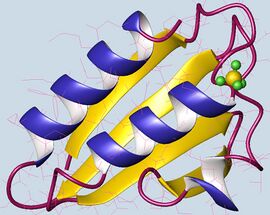Biology:Phosphocarrier protein
| Phosphotransferase system, phosphocarrier HPr protein | |||||||||||
|---|---|---|---|---|---|---|---|---|---|---|---|
 Phosphocarrier protein HPr, E. coli | |||||||||||
| Identifiers | |||||||||||
| Symbol | PTS_HPr_protein | ||||||||||
| Pfam | PF00381 | ||||||||||
| InterPro | IPR000032 | ||||||||||
| PROSITE | PDOC00318 | ||||||||||
| SCOP2 | 1ptf / SCOPe / SUPFAM | ||||||||||
| |||||||||||
Histidine-containing phosphocarrier protein (HPr) is a small cytoplasmic protein that is a component of the phosphoenolpyruvate-dependent sugar phosphotransferase system (PTS).[1][2]
The phosphoenolpyruvate-dependent sugar phosphotransferase system (PTS) is a major carbohydrate transport system in bacteria. The PTS catalyses the phosphorylation of sugar substrates during their translocation across the cell membrane. The mechanism involves the transfer of a phosphoryl group from phosphoenolpyruvate (PEP) via enzyme I (EI) to enzyme II (EII) of the PTS system, which in turn transfers it to a phosphocarrier protein (HPr).[3][4] In some bacteria HPr is a domain in a larger protein that includes an EIII(Fru) (IIA) domain and in some cases also an EI domain.
There is a conserved histidine in the N-terminus of HPr, which serves as an acceptor for the phosphoryl group of EI. In the central part of HPr there is a conserved serine which, in most Gram-positive bacteria and certain Gram-negative bacteria, is phosphorylated by an ATP-dependent protein kinase, a process which probably plays a regulatory role in sugar transport.[5]
References
- ↑ "Phosphoenolpyruvate:carbohydrate phosphotransferase systems of bacteria". Microbiol. Rev. 57 (3): 543–594. 1993. doi:10.1128/MMBR.57.3.543-594.1993. PMID 8246840.
- ↑ "The bacterial phosphoenolpyruvate: glycose phosphotransferase system". Annu. Rev. Biochem. 59 (1): 497–542. 1990. doi:10.1146/annurev.bi.59.070190.002433. PMID 2197982.
- ↑ "High-resolution structure of the phosphorylated form of the histidine-containing phosphocarrier protein HPr from Escherichia coli determined by restrained molecular dynamics from NMR-NOE data". J. Mol. Biol. 246 (1): 180–193. 1995. doi:10.1006/jmbi.1994.0075. PMID 7853396.
- ↑ "Refined structures of the active Ser83→Cys and impaired Ser46→Asp histidine-containing phosphocarrier proteins". Structure 2 (12): 1203–1216. 1994. doi:10.1016/S0969-2126(94)00122-7. PMID 7704530.
- ↑ "High-Resolution Structure of the Histidine-Containing Phosphocarrier Protein (HPr) from Staphylococcus aureus and Characterization of Its Interaction with the Bifunctional HPr Kinase/Phosphorylase". Journal of Bacteriology 186 (17): 5906–5918. 2004. doi:10.1128/JB.186.17.5906-5918.2004. PMID 15317796.
 |

